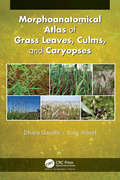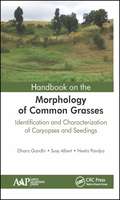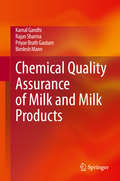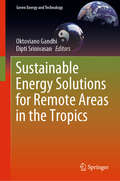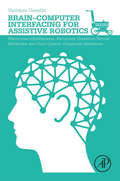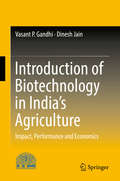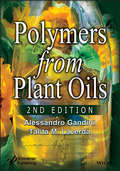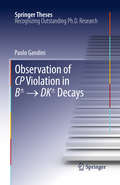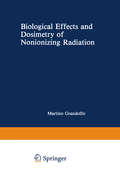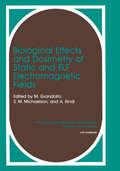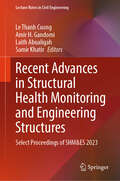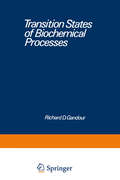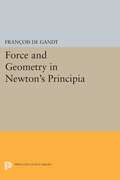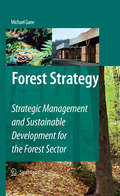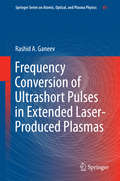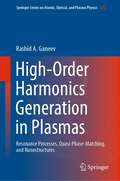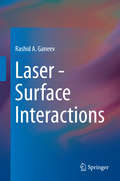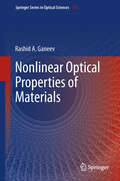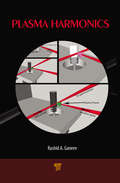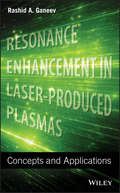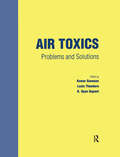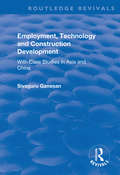- Table View
- List View
Morphoanatomical Atlas of Grass Leaves, Culms, and Caryopses
by Dhara Gandhi Susy AlbertThis new volume features the studied anatomical details of different parts of 100 wild grass species and provides a comprehensive overview of existing knowledge. Each of the three sections of the volume (leaf grass, culm, and caryopses) discusses and illustrates the diagnostic histological features, along with statistical analyses on the quantitative and qualitative data. The descriptions of these grasses, particularly those growing in the grasslands of the Panchmahal and Dahod districts of India, are supplemented with microphotographs and keys for the taxa concentrate upon diagnostic characters above the rank of genus, which will be helpful for the easy identification of the grasses, even in their vegetative stages before flowering. The cluster analysis uses the statistical analysis program Minitab for each part on the basis of the diagnostic features.In this volume, readers will be able to easily identify the grass species based on the anatomical features described here. The volume will be of great interest both to grass specialists and to generalists seeking state-of-the-art information on the diversity of grasses, the most ecologically and economically important of the families of flowering plants.
Handbook on the Morphology of Common Grasses: Identification and Characterization of Caryopses and Seedlings
by Dhara Gandhi Susy Albert Neeta PandyaThe grass family is one of the largest and most diverse families in the plant kingdom and is of great economic value. Grasses provide human beings and domestic animals with the main necessities of life, add diversity to the landscape and stability to the ground surface, and also provide ornamental and amenity value. The present handbook is a pictor
Chemical Quality Assurance of Milk and Milk Products
by Kamal Gandhi Rajan Sharma Priyae Brath Gautam Bimlesh MannThis book discusses quality-related aspects of milk and milk products, covering the various analytical procedures for testing the quality and composition. It also describes the adulteration of milk and milk products and the common as well as advanced techniques used to detect such adulteration. Further, the book examines food laws, guidelines and regulations laid down by FSSAI, CODEX, ISO, IDF and USFDA, and addresses the functioning of a number of international and national organizations, including the WTO, Codex Alimentarius Commission, and BIS. Familiarizing readers with the concepts of QC, TQM, PDCA cycle and related concepts of quality assurance, the book also provides information on other topics that indirectly contribute to the quality of milk and milk products, like the calibration of milk testing equipment, quality of water used in milk processing and the standardization of various chemicals used for testing. This book is a valuable resource for researchers and industry professionals dealing with dairy products.
Sustainable Energy Solutions for Remote Areas in the Tropics (Green Energy and Technology)
by Oktoviano Gandhi Dipti SrinivasanThis book covers multifaceted aspects of sustainable energy solutions for remote areas in the tropics, particularly focusing on Southeast Asia. With insights from both the academic world and real-life implementation, readers will gain an overview of the range of energy problems currently facing the remote tropics, and what potential solutions are available. The book provides a detailed overview of various energy needs in the Southeast Asian tropics, a region where a significant portion of the population still lives without access to electricity. It not only addresses technical solutions to the energy problems but also tackles the social and wider implications, offering readers a more holistic understanding of the potential held by renewable energy. The chapters are structured to present first an overview of the problem at hand, and then a description of the technologies that could potentially solve it. Applications of the technologies; business models that are now available or being developed; the impact of the technologies; and future, more sustainable solutions are all discussed. Given its in-depth analysis, the book will be of interest to energy professionals in the tropics, energy policymakers, and students studying sustainable energy.
Brain-Computer Interfacing for Assistive Robotics: Electroencephalograms, Recurrent Quantum Neural Networks, and User-Centric Graphical Interfaces
by Vaibhav GandhiBrain-computer interface (BCI) technology provides a means of communication that allows individuals with severely impaired movement to communicate with assistive devices using the electroencephalogram (EEG) or other brain signals. The practicality of a BCI has been possible due to advances in multi-disciplinary areas of research related to cognitive neuroscience, brain-imaging techniques and human-computer interfaces. However, two major challenges remain in making BCI for assistive robotics practical for day-to-day use: the inherent lower bandwidth of BCI, and how to best handle the unknown embedded noise within the raw EEG. Brain-Computer Interfacing for Assistive Robotics is a result of research focusing on these important aspects of BCI for real-time assistive robotic application. It details the fundamental issues related to non-stationary EEG signal processing (filtering) and the need of an alternative approach for the same. Additionally, the book also discusses techniques for overcoming lower bandwidth of BCIs by designing novel use-centric graphical user interfaces. A detailed investigation into both these approaches is discussed.An innovative reference on the brain-computer interface (BCI) and its utility in computational neuroscience and assistive roboticsWritten for mature and early stage researchers, postgraduate and doctoral students, and computational neuroscientists, this book is a novel guide to the fundamentals of quantum mechanics for BCIFull-colour text that focuses on brain-computer interfacing for real-time assistive robotic application and details the fundamental issues related with signal processing and the need for alternative approachesA detailed introduction as well as an in-depth analysis of challenges and issues in developing practical brain-computer interfaces.
Introduction of Biotechnology in India’s Agriculture: Impact, Performance and Economics
by Vasant P. Gandhi Dinesh JainBiotechnology can bring major breakthroughs in agriculture. The book examines the experience of introduction of biotechnology in Indian agriculture, specifically, examining the performance of Bt cotton versus non-Bt cotton across India’s major cotton states, namely Andhra Pradesh, Gujarat, Maharashtra and Tamil Nadu, which together account for nearly 70 percent of the country’s cotton production. Major advances in biotechnology have made it possible to directly identify genes, determine their functions, and transfer them from one organism to another. The advances have spawned many technologies and Bt cotton is one important outcome. Bt cotton has become one of the most widely cultivated transgenic crops and is currently grown in 21 countries - 11 developing and 10 industrialized countries. The Government of India was relatively late in permitting biotechnology, only approving the cultivation of three transgenic Bt cotton hybrids from April 2002. Many concerns were raised about their performance there was strong opposition from some quarters. In India, Gujarat and Maharastra were the first states to adopt them, followed by Andhra Pradesh, Karnataka, Tamil Nadu and Madhya Pradesh. Based on a sample of 694 farming households, the book examines and analyzes the performance on the yields, pesticide costs, seed costs, overall production costs and profits. It also reports on the environmental impacts, satisfaction with the technology and ways of improving its performance.
Polymers from Plant Oils
by Alessandro Gandini Talita M. LacerdaThe purpose of this monograph is to provide a thorough outlook on the topic related to the synthesis and characterization of original macromolecular materials derived from plant oils, an important part of the broader steadily growing discipline of polymers from renewable resources. The interest in vegetable oils as sources of biodiesel and materials has witnessed a remarkable growth of scientific and industrial interest since the beginning of the third millennium responding to the pressing drive to implement sustainability in the energy and materials sectors. The book highlights the most relevant strategies being pursued to elaborate polymers derived from a variety of common oils, by direct activation or through chemical modifications yielding novel monomers. Because glycerol is the main byproduct of biodiesel production, it is treated here as the other logical source of macromolecular synthesis. Each of the different approaches is illustrated by an introductory layout of the underlying chemical mechanisms, followed by examples of notable achievements in terms of the properties and potential applications of the ensuing materials, which span a wide range of structures and performances. In particular, original pathways involving click-chemistry reactions as thiol-ene and Diels-Alder couplings and metathesis polymerizations are discussed and shown to reflect the involvement of a growing number of research programs worldwide. It is important to underline that the book is not a scientific review covering the details of all relevant literature, but instead a reasoned and well-documented presentation of the state-of-the-art aimed at professionals in the field of polymer science, as well as at both undergraduate and graduate students and, more generally at chemists interested in the rational exploitation of renewable resources.
Polymers from Plant Oils
by Alessandro Gandini Talita M. LacerdaThe purpose of this monograph is to provide a thorough outlook on the topic related to the synthesis and characterization of original macromolecular materials derived from plant oils, an important part of the broader steadily growing discipline of polymers from renewable resources. The interest in vegetable oils as sources of biodiesel and materials has witnessed a remarkable growth of scientific and industrial interest since the beginning of the third millennium responding to the pressing drive to implement sustainability in the energy and materials sectors. The book highlights the most relevant strategies being pursued to elaborate polymers derived from a variety of common oils, by direct activation or through chemical modifications yielding novel monomers. Because glycerol is the main byproduct of biodiesel production, it is treated here as the other logical source of macromolecular synthesis. Each of the different approaches is illustrated by an introductory layout of the underlying chemical mechanisms, followed by examples of notable achievements in terms of the properties and potential applications of the ensuing materials, which span a wide range of structures and performances. In particular, original pathways involving click-chemistry reactions as thiol-ene and Diels-Alder couplings and metathesis polymerizations are discussed and shown to reflect the involvement of a growing number of research programs worldwide. It is important to underline that the book is not a scientific review covering the details of all relevant literature, but instead a reasoned and well-documented presentation of the state-of-the-art aimed at professionals in the field of polymer science, as well as at both undergraduate and graduate students and, more generally at chemists interested in the rational exploitation of renewable resources.
Observation of CP Violation in B± → DK± Decays (Springer Theses)
by Paolo GandiniCP violation is a well-established phenomenon in particle physics, but until 2001 it was only observed in kaons. In the last decade, several matter-antimatter asymmetries have been observed in neutral B mesons in line with the expectations of the Standard Model of the weak interaction. Direct CP violation is also expected in the decay rates of charged B+ mesons versus that of B- mesons, though the greatest effects are present in a decay that occurs just twice in 10 million decays. Such rarity requires huge samples to study and this is exactly what the LHC, and its dedicated B-physics experiment LHCb provide. This thesis presents an analysis of the first two years of LHCb data. The author describes the first observation of the rare decay, B- → DK-, D → π-K+ and the first observation of direct CP violation in this B decay. The work constitutes essential information on the experiment’s measurement of a fundamental parameter of the theory and stands as a benchmark against which subsequent analyses of this type will be compared.
Biological Effects and Dosimetry of Nonionizing Radiation: Radiofrequency and Microwave Energies (Nato Science Series A: #49)
by Martino GandolfoDuring the last 35 years, there has been considerable develop ment and increase in the number of devices that emit nonionizing radiant energies. These energies such as radiofrequency including microwaves are used in all sectors of our society for military, industrial. telecommunications, medical, and consumer applications. This increase in sources of nonionizing radiant energies has resulted in growing interest on the part of government regulatory agencies, industrial and military physicians, research workers, clinicians, and environmentalists. Although there is information on biologic effects and potential hazards to man from exposure to microwave/radiofrequency energies, considerable confusion and misinformation has permeated not only the public press but also some scientific and technical publications. Because of the complexity of the interactions of nonionizing radiation in biological systems, an inter-disciplinary approach is necessary to assess and elucidate the problems that evolve as this field advances and as the use of these energies expands. It is important to maintain a proper perspective and assess realistically the biomedical effects of these radiant energies so that the worker or general public will not be unduly exposed nor will research, development and beneficial utilization of these energies be hampered or restricted by an undue concern for effects which may be nonexis tent or minimal in comparison to other environmental hazards.
Biological Effects and Dosimetry of Static and ELF Electromagnetic Fields: (pdf) (Problems in Practice)
by Martino Gandolfo A. Rindi S. M. MichaelsonRecent Advances in Structural Health Monitoring and Engineering Structures: Select Proceedings of SHM&ES 2023 (Lecture Notes in Civil Engineering #460)
by Amir H. Gandomi Le Thanh Cuong Samir Khatir Laith AbualigahThis book presents the select proceedings of the 3rd International Conference on Structural Health Monitoring & Engineering Structures (SHM&ES 2023). It covers the recent advances in the fields related to structural health monitoring, damage detection and assessment, non-destructive testing, inverse problems, optimization, artificial neural networks, and evaluation. This book is useful for researchers and professionals working in the field of health monitoring of engineering structures.
Transition States of Biochemical Processes
by R. GandourThe transItIOn-state theory has been, from the point of its inception, the most influential principle in the development of our knowledge of reaction mechanisms in solution. It is natural that as the field of biochemical dynamics has achieved new levels of refinement its students have increasingly adopted the concepts and methods of transition-state theory. Indeed, every dynamical problem of biochemistry finds its most elegant and economical statement in the terms of this theory. Enzyme catalytic power, for example, derives from the interaction of enzyme and substrate structures in the transition state, so that an understanding of this power must grow from a knowledge of these structures and interactions. Similarly, transition-state interactions, and the way in which they change as protein structure is altered, constitute the pivotal feature upon which molecular evolution must turn. The complete, coupled dynamical system of the organism, incorporating the transport of matter and energy as well as local chemical processes, will eventually have to yield to a description of its component transition-state structures and their energetic response characteristics, even if the form of the description goes beyond present-day transition-state theory. Finally, the importance of biochemical effectors in medicine and agriculture carries the subject into the world of practical affairs, in the use of transition-state information for the construction of ultra potent biological agents.
Force and Geometry in Newton's "Principia"
by François De Gandt Curtis WilsonIn this book François De Gandt introduces us to the reading of Newton's Principia in its own terms. The path of access that De Gandt proposes leads through the study of the geometrization of force. The result is a highly original meditation on the sources and meaning of Newton's magnum opus.In Chapter I De Gandt presents a translation of and detailed commentary on an earlier and simpler version of what in 1687 became Book I of the Principia; here in clearer and starker outline than in the final version, the basic principles of Newton's dynamics show forth. Chapter II places this dynamics in the intellectual context of earlier efforts--the first seeds of celestial dynamics in Kepler, Galileo's theory of accelerated motion, and Huygens's quantification of centrifugal force--and evaluates Newton's debt to these thinkers. Chapter III is a study of the mathematical tools used by Newton and their intellectual antecedents in the works of Galileo, Torricelli, Barrow, and other seventeenth-century mathematicians. The conclusion discusses the new status of force and cause in the science that emerges from Newton's Principia.Originally published in 1995.The Princeton Legacy Library uses the latest print-on-demand technology to again make available previously out-of-print books from the distinguished backlist of Princeton University Press. These editions preserve the original texts of these important books while presenting them in durable paperback and hardcover editions. The goal of the Princeton Legacy Library is to vastly increase access to the rich scholarly heritage found in the thousands of books published by Princeton University Press since its founding in 1905.
Forest Strategy: Strategic Management and Sustainable Development for the Forest Sector
by Michael GaneThis ground-breaking book combines detailed analysis of the forest sector with modern strategic management principles to develop a vision for sustainable forest management which is both practical and theoretically robust. The book adopts a holistic approach to propose a new theoretical framework for this once traditional sector; one which reconciles current thinking in strategic management with natural resource management.
Frequency Conversion of Ultrashort Pulses in Extended Laser-Produced Plasmas (Springer Series on Atomic, Optical, and Plasma Physics #89)
by Rashid A GaneevThis book offers a review of the use of extended ablation plasmas as nonlinear media for HHG of high-order harmonic generation (HHG). The book describes the different experimental approaches, shows the advantages and limitations regarding HHG efficiency and discusses the particular processes that take place at longer interaction lengths, including propagation and quasi-phase matching effects. It describes the most recent approaches to harmonic generation in the extreme ultraviolet (XUV) range with the use of extended plasma plumes, and how these differ from more commonly-used gas-jet sources. The main focus is on studies using extended plasmas, but some new findings from HHG experiments in narrow plasma plumes are also discussed. It also describes how quasi-phase-matching in modulated plasmas, as demonstrated in recent studies, has revealed different means of tuning enhanced harmonic groups in the XUV region. After an introduction to the fundamental theoretical and experimental aspects of HHG, a review of the most important results of HHG in narrow plasmas is presented, including recent studies of small-sized plasma plumes as emitters of high-order harmonics. In Chapter 2, various findings in the application of extended plasmas for harmonic generation are analyzed. One of the most important applications of extended plasmas, the quasi-phase-matching of generated harmonics, is demonstrated in Chapter 3, including various approaches to the modification of perforated plasma plumes. Chapter 4 depicts the nonlinear optical features of extended plasmas produced on the surfaces of different non-metal materials. Chapter 5 is dedicated to the analysis of new opportunities for extended plasma induced HHG. The advantages of the application of long plasma plumes for HHG, such as resonance enhancement and double-pulse method, are discussed in Chapter 6. Finally, a summary section brings together all of these findings and discuss the perspectives of extended plasma formations for efficient HHG and nonlinear optical plasma spectroscopy. The book will be useful for students and scholars working in this highly multidisciplinary domain involving material science, nonlinear optics and laser spectroscopy. It brings the new researcher to the very frontier of the physics of the interaction between laser and extended plasma; for the expert it will serve as an essential guide and indicate directions for future research.
High-Order Harmonics Generation in Plasmas: Resonance Processes, Quasi-Phase-Matching, and Nanostructures (Springer Series on Atomic, Optical, and Plasma Physics #122)
by Rashid A. GaneevThis book comprises a detailed consideration of novel approaches developed in the field of frequency conversion of laser sources in laser-induced plasmas during the last few years. The aim of the book is to support researchers and other readers in their development in the area of high-order nonlinear spectroscopy. Particularly, the advanced studies of nanoparticles and quantum dots for the formation of new sources of radiation in different short-wavelength spectral ranges show the ways to further implement the specific features of small-sized species in a relatively new field of study—laser ablation induced high-order harmonics generation spectroscopy.Researchers involved in the development of new methods of frequency conversion will benefit from finding the most recent advances in this field. Undergraduate students will discover interesting information about recent findings in plasma harmonic research. Additionally, the usefulness of the book will be demonstrated by the potential applications of the new knowledge developed during recent years for ultrafast pulse generation using the proposed schemes of plasma-light interaction. Thus, the audience may also include those researchers involved in state-of-the-art developments in attophysics. Additionally, any professionals interested in the application of the advanced techniques for material science will also benefit from updating their knowledge of new methods of material studies using high-order nonlinear spectroscopy.
Laser - Surface Interactions
by Rashid A. GaneevThis book is about the interaction of laser radiation with various surfaces at variable parameters of radiation. As a basic principle of classification we chose the energetic or intensity level of interaction of laser radiation with the surfaces. These two characteristics of laser radiation are the most important parameters defining entire spectrum of the processes occurring on the surfaces during interaction with electromagnetic waves. This is a first book containing a whole spectrum of the laser-surface interactions distinguished by the ranges of used laser intensity. It combines the surface response starting from extremely weak laser intensities (~1 W cm-2) up to the relativistic intensities (~1020 W cm-2 and higher). The book provides the basic information about lasers and acquaints the reader with both common applications of laser-surface interactions (laser-related printers, scanners, barcode readers, discs, material processing, military, holography, medicine, etc) and unusual uses of the processes on the surfaces under the action of lasers (art conservation, rangefinders and velocimeters, space and earth explorations, surface engineering and ablation, and others). The scientific applications of laser-surfaces interactions (surface optical nonlinearities, surface enhanced Raman spectroscopy, surface nanostructuring, nanoripples and clusters formation, X-ray lasers and harmonic generation from the surfaces) are discussed from the point of view of the close relations between the properties of surface and matter, which is a cornerstone of most of studies of materials.The novelty of the approach developed in Laser - Surface Interactions is related with the interconnection of scientific studies with numerous applications of the laser-surface interactions separated in different chapters by the ranges of laser intensities. We present most recent achievements in this field. The book provides valuable information for different ranges of reader's preparedness to the laser-related topics (from unprepared readers, to students, engineers and researchers, professionals and academics).
Nonlinear Optical Properties of Materials (Springer Series in Optical Sciences)
by Rashid A. GaneevThis book is mostly concerned on the experimental research of the nonlinear optical characteristics of various media, low- and high-order harmonic generation in different materials, and formation, and nonlinear optical characterization of clusters. We also demonstrate the inter-connection between these areas of nonlinear optics. Nonlinear optical properties of media such as optical limiting can be applied in various areas of science and technology. To define suitable materials for these applications, one has to carefully analyse the nonlinear optical characteristics of various media, such as the nonlinear refractive indices, coefficients of nonlinear absorption, saturation absorption intensities, etc. Knowing the nonlinear optical parameters of materials is also important for describing the propagation effects, self-interaction of intense laser pulses, and optimisation of various nonlinear optical processes. Among those processes one can admit the importance of the studies of the frequency conversion of coherent laser sources. The area of interest for nonlinear optical characterization of materials is also closely related with new field of nanostructures formation and application during laser-matter interaction.We show how the nonlinear optical analysis of materials leads to improvement of their high-order nonlinear optical response during the interaction with strong laser fields. Ablation-induced nanoparticles formation is correlated with their applications as efficient sources of coherent short-wavelength photons. From other side, recent achievements of harmonic generation in plasmas are closely related with the knowledge of the properties of materials in the laser plumes. All of these studies are concerned with the low-order nonlinear optical features of various materials. The novelty of the approach developed in present book is related with inter-connection of those studies with each other.
Plasma Harmonics
by Rashid A. GaneevPlasma harmonics is a new field of laser spectroscopy. The use of the solid elements of the periodic table, together with thousands of complex solid-state samples, largely extends the range of materials employed in plasma harmonics in contrast to the few light rare gases that are typically used. Thus the exploration of practically any available sol
Resonance Enhancement in Laser-Produced Plasmas: Concepts and Applications
by Rashid A. GaneevA comprehensive guide to a new technology for enabling high-performance spectroscopy and laser sources Resonance Enhancement in Laser-Produced Plasmas offers a guide to the most recent findings in the newly emerged field of resonance-enhanced high-order harmonic generation using the laser pulses propagating through the narrow and extended laser-produced plasma plumes. The author—a noted expert in the field—presents an introduction and the theory that underpin the roles of resonances in harmonic generation. The book also contains a review of the most advanced methods of plasma harmonics generation at the conditions of coincidence of some harmonics, autoionizing states, and some ionic transitions possessing strong oscillator strengths. Comprehensive in scope, this text clearly demonstrates the importance of resonance-enhanced nonlinear optical effects leading to formation of efficient sources of coherent extreme ultraviolet radiation that can be practically applied. This important resource: Puts the focuses on novel applications of laser-plasma physics, such as the development of ultrashort-wavelength coherent light sources Details both the theoretical and experimental aspects of higher-order harmonic generation in laser-produced plasmas Contains information on early studies of resonance enhancement of harmonics in metal-ablated plasmas Analyzes the drawbacks of different theories of resonant high order harmonic generation Includes a discussion of the quasi-phase-matching and properties of semiconductor plasmas Written for researchers and students in the fields of physics, materials science, and electrical engineering who are interested in laser physics and optics, Resonance Enhancement in Laser-Produced Plasmas offers an introduction to the topic and covers recent experimental studies of various resonance processes in plasmas leading to enhancement of single harmonic.
Resonance Enhancement in Laser-Produced Plasmas: Concepts and Applications
by Rashid A. GaneevA comprehensive guide to a new technology for enabling high-performance spectroscopy and laser sources Resonance Enhancement in Laser-Produced Plasmas offers a guide to the most recent findings in the newly emerged field of resonance-enhanced high-order harmonic generation using the laser pulses propagating through the narrow and extended laser-produced plasma plumes. The author—a noted expert in the field—presents an introduction and the theory that underpin the roles of resonances in harmonic generation. The book also contains a review of the most advanced methods of plasma harmonics generation at the conditions of coincidence of some harmonics, autoionizing states, and some ionic transitions possessing strong oscillator strengths. Comprehensive in scope, this text clearly demonstrates the importance of resonance-enhanced nonlinear optical effects leading to formation of efficient sources of coherent extreme ultraviolet radiation that can be practically applied. This important resource: Puts the focuses on novel applications of laser-plasma physics, such as the development of ultrashort-wavelength coherent light sources Details both the theoretical and experimental aspects of higher-order harmonic generation in laser-produced plasmas Contains information on early studies of resonance enhancement of harmonics in metal-ablated plasmas Analyzes the drawbacks of different theories of resonant high order harmonic generation Includes a discussion of the quasi-phase-matching and properties of semiconductor plasmas Written for researchers and students in the fields of physics, materials science, and electrical engineering who are interested in laser physics and optics, Resonance Enhancement in Laser-Produced Plasmas offers an introduction to the topic and covers recent experimental studies of various resonance processes in plasmas leading to enhancement of single harmonic.
Air Toxics: Problems and Solutions
by Kumar GanesanThis timely new workbook is the result of a year-long effort by a group of university professors who first met at Montana Tech during the summer of 1994 for a college faculty workshop. The workshop was funded by the National Science Foundation's support for those faculty developing courses in the newly emerging field of air toxics. Part I of the book contains over 100 problems dealing with a variety of topics in this area. Part II provides detailed solutions. The problems and solutions provided will become a useful resource for the training of engineers and scientists who are or soon will be working in the field.
Air Toxics: Problems and Solutions
by Kumar GanesanThis timely new workbook is the result of a year-long effort by a group of university professors who first met at Montana Tech during the summer of 1994 for a college faculty workshop. The workshop was funded by the National Science Foundation's support for those faculty developing courses in the newly emerging field of air toxics. Part I of the book contains over 100 problems dealing with a variety of topics in this area. Part II provides detailed solutions. The problems and solutions provided will become a useful resource for the training of engineers and scientists who are or soon will be working in the field.
Employment, Technology and Construction Development: With Case Studies in Asia and China (Routledge Revivals)
by Sivaguru GanesanThis title was first published in 2000: An in depth analysis of employment and technology issues in the housing and construction industries of developing countries, in the context of globalization of economies and increased opportunities for advanced technology transfer. Supported by case studies from Asia including the misallocation of resources that led to the Asian crisis of 1997 and the experience of Shanghai in advanced technology transfer. Ganesan advances a number of strategies to achieve higher employment creation, a proper mix of resources and sustained growth.
